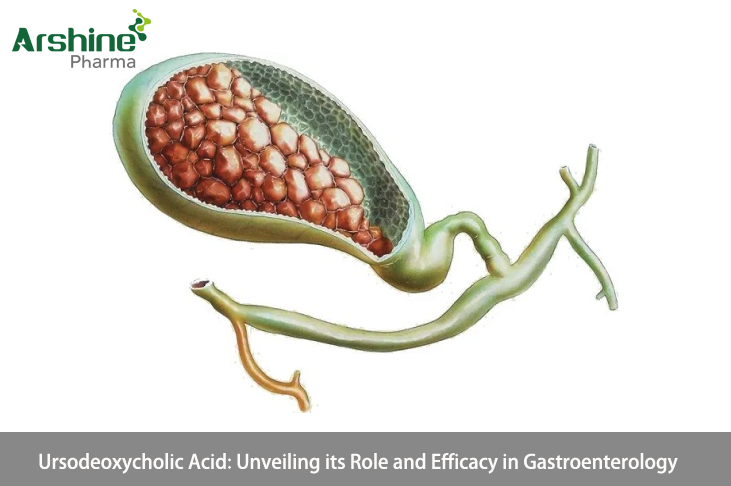
Introduction: Ursodeoxycholic acid (UDCA), a naturally occurring bile acid derivative, has emerged as a cornerstone in the field of gastroenterology due to its multifaceted therapeutic properties. With its origins rooted in traditional medicine, UDCA has transcended time to become a pivotal therapeutic agent in managing a spectrum of hepatobiliary disorders. This comprehensive exploration delves into the nuanced role and impressive efficacy of UDCA in the realm of gastroenterology.
Bile Acid Metabolism and Cholestasis: To comprehend UDCA's role, it is vital to fathom its influence on bile acid metabolism. Cholestasis, characterized by impaired bile flow, can lead to the accumulation of toxic bile acids, causing hepatocellular injury. UDCA orchestrates a delicate balance, modulating the composition of bile acids to alleviate cholestatic stress. It promotes the secretion of less hydrophobic bile acids, diminishing the toxic burden on hepatocytes and thwarting the vicious cycle of liver damage.
Primary Biliary Cholangitis (PBC): UDCA's efficacy is perhaps most renowned in the treatment of primary biliary cholangitis (PBC), an autoimmune liver disease targeting the intrahepatic bile ducts. PBC's hallmark is the progressive destruction of these ducts, ultimately culminating in cirrhosis and hepatic failure. Clinical trials and long-term studies have spotlighted UDCA's remarkable ability to slow disease progression, delay the need for liver transplantation, and enhance survival rates in PBC patients. Its mechanisms involve ameliorating cholestasis, reducing inflammation, and preserving liver function.
Primary Sclerosing Cholangitis (PSC): The enigmatic primary sclerosing cholangitis, characterized by inflammation and fibrosis of the bile ducts, has eluded definitive treatment. UDCA's role in PSC remains debated, with studies showcasing varying outcomes. Some trials suggest potential benefits in specific subsets of PSC patients, such as those with concurrent inflammatory bowel disease. While UDCA's universal efficacy in PSC is uncertain, ongoing research seeks to unveil its precise role in this complex condition.
Gallstone Dissolution: UDCA's influence extends to gallstone management, particularly cholesterol gallstones. By decreasing the cholesterol saturation index of bile, UDCA promotes the solubilization of cholesterol, aiding in the dissolution of gallstones. Its efficacy is most pronounced in small, radiolucent gallstones, making it a viable alternative to surgical intervention for select patients. Moreover, UDCA therapy post-gallstone dissolution helps prevent gallstone recurrence.
Non-alcoholic Fatty Liver Disease (NAFLD) and Non-alcoholic Steatohepatitis (NASH): The global surge in non-alcoholic fatty liver disease and its inflammatory counterpart, non-alcoholic steatohepatitis, underscores the need for effective interventions. UDCA, by mitigating oxidative stress, inflammation, and hepatic steatosis, offers potential in NAFLD and NASH management. While substantial evidence is yet to crystallize its role, ongoing studies probe UDCA's impact on disease progression, warranting optimism for its future applications.
Drug-Induced Cholestasis: A notable testament to UDCA's versatility lies in its utility against drug-induced cholestasis. Certain medications can disrupt bile flow, triggering cholestasis and hepatotoxicity. UDCA intervenes by modulating bile acid composition, alleviating cholestatic injury, and potentially aiding in the restoration of normal hepatobiliary function. Its use as an adjunct therapy alongside hepatotoxic drugs showcases its potential to ameliorate treatment-related complications.
Safety Profile and Adverse Effects: UDCA's safety profile is generally favorable, with most adverse effects being mild and transient. Gastrointestinal disturbances like diarrhea are the most common. However, these can often be mitigated by adjusting the dosage. In rare instances, allergic reactions and elevated transaminases have been reported. Importantly, UDCA's safety during pregnancy is a critical consideration, as it can be used to manage certain intrahepatic cholestasis of pregnancy cases.
Conclusion: Ursodeoxycholic acid's journey from traditional medicine to a cornerstone of modern gastroenterology is a testament to its versatile therapeutic potential. Its ability to counteract cholestatic stress, preserve liver function, and ameliorate a spectrum of hepatobiliary disorders underscores its pivotal role. As ongoing research continues to unravel its intricacies and extend its applications, UDCA stands as a beacon of hope for patients grappling with a range of hepatobiliary ailments. Its efficacy not only addresses the physiological intricacies of these conditions but also fosters a better quality of life for those it serves.
